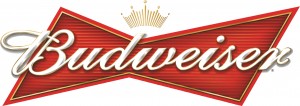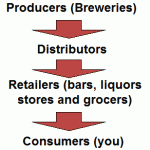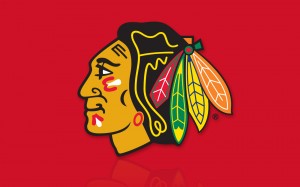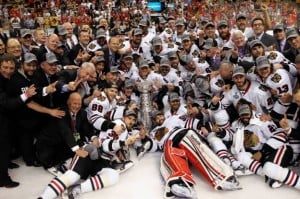One important thing to take away from Operations Management (OM) is how relevant it is in all branches of business. Developing an understanding for operations management can be the key to solving many problems in a business regardless of your field. This lesson became apparent to me when considering lectures from both my management and marketing course. Marketing concerns itself with the 4 P’s or price, product, promotion, and place. What I want to focus on in this blog is place, which coincidently supply-chain management is one of the OM strategic decisions and a major way companies can reduce cost. Anheuser-Busch’s Budweiser has implemented a supply chain that is worth taking a closer look at.
First, it is important to note that all alcohol producers must adhere to the Three-Tier System, which simply states the distribution of alcohol must include an independent intermediary between producers and retailers to eliminate unfair practices by producers. In other words, “the distributor is not allowed to purchase shelf space or exclusivity, furnish equipment like draft coolers, offer loans or create a feeling of obligation, or offer discriminatory promotional pricing” (Spiess). What this means for alcohol producers that their supply-chain channel is already determined for them; they do not have the option of choosing between a direct or indirect channel structure. Budweiser must go through a wholesaler/distributor to reach the retailer.
Since Budweiser must have an indirect channel structure paying for distributors will impact their costs. Thus, finding ways to lower the cost becomes the next step. When dealing with the three-tier system, Budweiser must make strategic supply-chain management decisions that will benefit their business. Looking to OM becomes a crucial step. Thus, some brewers such as Anheuser-Busch and Miller have found ways to go around the requirement of an independent distributor without actually breaking the rule. Due to their wealth and success, Anheuser-Busch essentially has ownership of their distributors without actually owning the distribution channel. For example, “In 1977, Anheuser-Busch had their distributors sign an “exclusivity incentive program” which didn’t require the distributor carry only A-B products, but gave huge benefits if they did drop all competitors” (Spiess). Through incentive programs such as these, Budweiser is able to implement a vertical forward integration channel, in which they essentially control their wholesalers.
Of course problems struck when independent distributors found out that “Anheuser-Busch has more than 500 distributors across the country…nearly all of which are independent companies with an exclusive contract to sell A-B beer in a certain geographical area” (Logan) and started to push a bill through the state legislature to stop these practices. They are arguing that Anheuser-Busch is gaining profits by saving on what they normally would have had to pay the distributor (Logan). Wholesalers believe these producers are exploiting the system meant to protect distributor rights. On the other hand, Anheuser-Busch argues as a smart supply-chain management decision, it makes good business sense to hire wholesalers who are loyal to the Budweiser brand rather than those who also carry their competition. Thus, Anheuser-Busch minimizes costs while distributors are guaranteed its business.
While this is a great way for Anheuser-Busch to minimize cost, is it fair to the wholesaler who will not sign the incentive agreement and is then losing this revenue?
Should alcohol manufacturers such as Budweiser be able to own their own distributors as part of their supply chain management?
Sources:
http://www.fermentarium.com/industry/how-the-three-tiered-beer-distribution-system-works/



